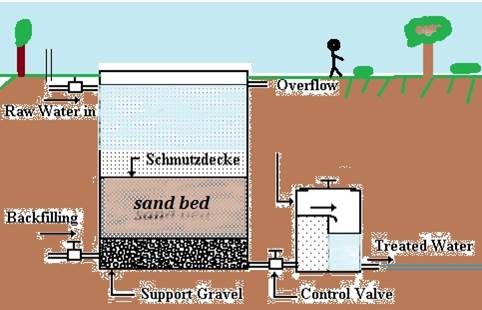
Slow Sand Filter
(Biological Filter)
• Elements of a slow sand filter
1. Supernatant or raw water
2. Bed of graded sand (on a support of gravel)
3. Under – drainage system
4. A system of filter control valves
1. Supernatant water:
• Depth varies from 1 - 1.5meters
• Serves two important purposes:
a) Provides a constant head of water
• This overcomes the resistance of the filter bed and promote downward flow of water through the sand bed
b) Provides waiting period of some hours (3 to 12 hours depending upon the filtration velocity)
• This allows the water to undergo partial purification by sedimentation, oxidation and particle agglomeration
• The level of the supernatant water is always kept constant
2. Sand bed:
• It is the most important part of the filter
• The thickness is about 1 meter
• The sand grains are carefully chosen
– Round shaped and
– Diameter of 0.2 to 0.3 mm
– Free of clay and organic matter
• The sand bed is supported by a layer of graded gravel
– This is 30 – 40 cm deep
– Prevents the fine sand from being washed into the drainage pipes
• The purpose of the sand bed:
– Provides a vast surface area
– Water percolates though the sand bed very slowly , (≥two hours)
– During this time purification occurs through:
• Mechanical straining
• Sedimentation’
• Adsorption
• Oxidation and
• Bacteria action
– The rate of filtration is adjusted to lie between 0.1 0.4 ml/ hour/ per square meter of sand bed surface
Vital Layer (within the sand bed of SLOW sand filter):
• When the filter is newly laid, it acts merely as a mechanical strainer, it is not ‘biological’ at this time
• But soon, the surface of the sand bed gets covered with a slimy growth known as “Schmutzdecke”
• This is a zoogleal layer or biological layer
• It is living layer hence k/a the ‘vital layer’
• This slimy and gelatinous layer consists of:
– Threadlike algae
– Plankton, diatoms and bacteria
• When this layer get formed, this is k/a ‘ripening’ of the filter
• May take several days to form fully
• Once fully formed it extend for 2 – 3 cm into the top portion of the sand bed
• This vial layer is the ‘heart’ of the slow sand filter
• The vital layer:
– Removes organic matter
– Holds back bacteria and
– Oxidizes ammoniacal nitrogen into nitrated and
– Helps in yielding a bacteria free water
• Hence, until the vital layer is fully formed, the first few days filtrate is usually run to waste
3. Under drainage system
• At the bottom of the filter bed
• Consists of porous or perforated pipes
• These serve the following purposes:
1. Provide an outlet for filtered water and
2. Supporting the filter medium above
• Filter box: the first 3 elements are contained in the filter box
1. It is an open box
2. Rectangular
3. 2.5 to 4 meters deep
4. Built wholly or partially below ground
5. The walls may be made of stone, brick or cement
6. Hence it contains the following layers from top to bottom:
1. Supernatant water – 1 to 1.5 m
2. Sand bed – 1.2 m
3. Gravel support – 0.30 m
4. Filter bottom – 0.16 m
4. Filter control
• Constituted of certain valves and devices which are incorporated in the outlet pipe system
• The purpose is to maintain a constant rate of filtration
• An important component is the ‘Venturi meter’
– This measures the bed resistance or ‘loss of head’
– When resistance builds up, the operator opens the regulating valve to ensure a steady rate of filtration
– When the ‘loss of head’ exceeds 1.3 m, it is uneconomical to run the filter
Filter cleaning
• Filter may run for weeks or months without cleaning
• When the bed resistance reaches to such an extent that the regulating valve has to be kept fully open: it is time to clean the filter bed
• At this stage, the supernatant water is drained off
• The sand bed is cleaned by ‘scraping’ off the top portion of the sand layer to a depth of 1 – 2 cm
• This operation may be carried out by unskilled laborers using hand tools or by mechanical equipment
• After several years of operation and 20 – 30 scrapings, the thickness of the sand bed will have reduced to about 0.5 – 0.8 m
• Then the plant is closed down and a new bed is constructed
Advantages:
• Simple to construct
• Cost of construction is cheaper than that of rapid sand filters
• Does not need chemical coagulation of water prior to filtering unlike rapid sand filters, only sedimentation is sufficient
• Does not need highly skilled operators
• The physical, chemical and bacteriological quality of filtered water is very high
– Slow sand filter have been shown to reduce total bacterial counts by 99.99% and E.coli count by 99.90%
Disadvantages:
• Occupies large area
• Slow rate of filtration
• Needs regular scraping of sand bed for cleaning
• In recent years biological or slow sand filters are mistakenly considered as old fashioned
References:
• Park’s Textbook of Preventive and Social Medicine
OT and OTA test: http://www.ihatepsm.com/blog/orthotolidine-ot-test-and-orthotolidine-%E2...
Membrane processes in water purification: http://www.ihatepsm.com/blog/membrane-processes-treatment-drinking-water
Super Chlorination and Break Point Chlorination: http://www.ihatepsm.com/blog/super-chlorination-and-break-point-chlorina...
Slow sand filter: http://www.ihatepsm.com/blog/slow-sand-filter-biological-filter
Rapid sand filter: http://www.ihatepsm.com/blog/rapid-sand-filter-mechanical-filter
Purification of water at a large scale: http://www.ihatepsm.com/blog/water-purification-large-scale-water-supply
Criteria for a Chemical to be Suitable as Water Disinfectant in Water Supplies: http://www.ihatepsm.com/blog/criteria-chemical-be-suitable-water-disinfe...
Water Supplies Disinfection with Chlorination: http://www.ihatepsm.com/blog/water-supplies-disinfection-chlorination
Principles of Chlorination: http://www.ihatepsm.com/blog/principles-chlorination
Methods of Chlorination in Water Supplies: http://www.ihatepsm.com/blog/methods-chlorination-water-supplies
Horrock's Apparatus: http://www.ihatepsm.com/blog/horrock%E2%80%99s-apparatus
Disinfection of well during emergency: http://www.ihatepsm.com/blog/disinfection-wells-during-emergency-%E2%80%...
Double Pot method: http://www.ihatepsm.com/blog/disinfection-wells-during-emergency-%E2%80%...
Disinfection of Wells: http://www.ihatepsm.com/blog/disinfection-wells
OT and OTA test: http://www.ihatepsm.com/blog/ot-and-ota-test
Domestic or Household Purification of Water: http://www.ihatepsm.com/blog/domestic-or-household-purification-water
